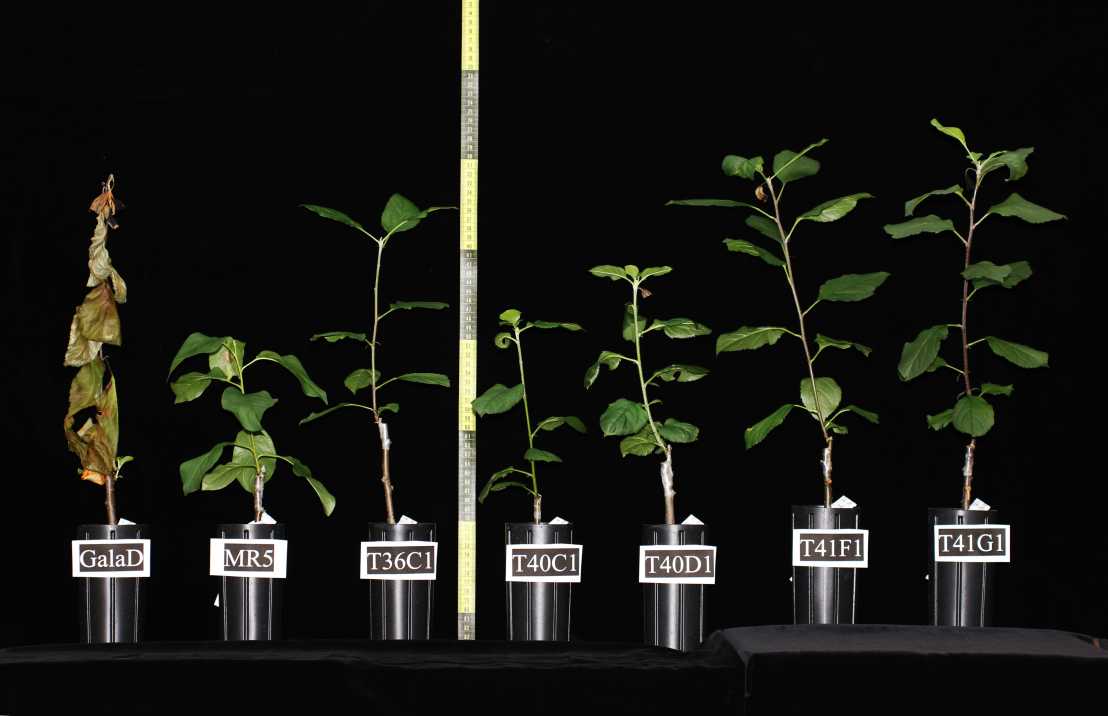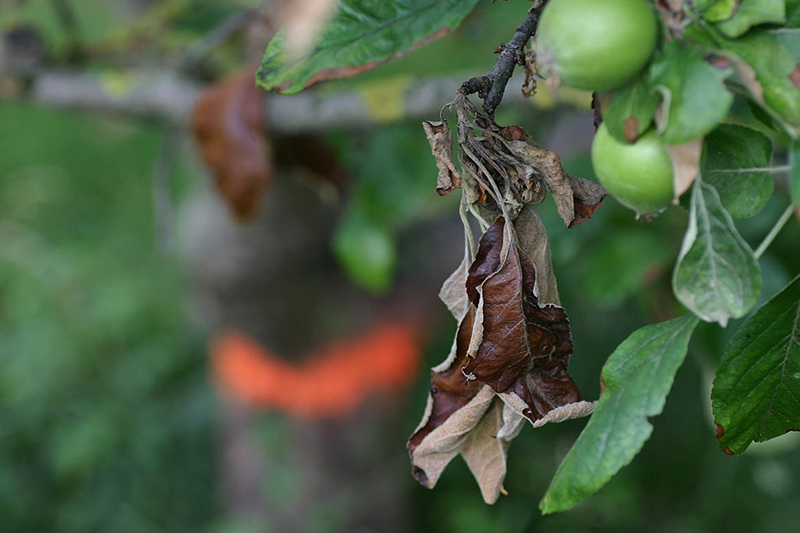Fire-blight resistant apples
Researchers from ETH Zurich and the Julius Kühn Institute in Germany have created the first fire-blight-resistant apple. With the aid of so-called cis-genetic engineering, they transfered a resistance gene from a wild apple into the genome of a Gala apple. Tests in the greenhouse indicate that the gene is effective in protecting the tree against the disease.
Fruit farmers dread fire blight. The infection keeps flaring up again and causes considerable damage to apple plantations. In 2007, when the last major epidemic hit Switzerland, the damage the country suffered cost CHF 50 million and 250,000 trees had to be destroyed. Farmers primarily use sprays containing the antibiotic streptomycin against the pathogen, the bacterium Erwinia amylovora – a controversial method to save fruit trees and harvests.
A team of researchers headed by ETH-Zurich plant pathologist Cesar Gessler and from the Julius Kühne Institute in Germany report a genetically modified apple of the popular Gala variety in the latest issue of Plant Biotechnology Journal that is resistant to fire blight. In an earlier issue of this journal, the researchers presented an apple tree of the same variety that can ward off scab, a common fungal disease, thanks to the insertion of a scab resistance gene of a wild apple.
Single gene provides sufficient protection
The researchers succeeded in identifying and isolating the gene for fire-blight resistance in a wild apple for the first time and confirming its function as a resistance-mediating gene. The gene carries the genetic code for a protein that recognises a surface protein of the pathogen, triggering a defence response in the plant affected. This one, single gene is sufficient to protect the plant against the disease.

Gessler and his collaborators were using so-called cis-genetic engineering. Additional genes are incorporated into cis-gene organisms using the biotechnological methods available. However, these are not foreign to the species, as in the case of so-called transgenic organisms. Instead, the apple only receives genes from another variety of apple. Although the gene was marked with other genes that were foreign to the species to discern whether the gene transfer was successful, the researchers managed to remove these foreign genes from the genome of the Gala apple afterwards so that only the wild-apple genes remained.
The researchers tested the fire blight resistance properties of the cis-gene apple trees in the greenhouse at the Agroscope research facility in Wädenswil and in Germany by infecting them with fire blight. The results revealed that the resistance gene took effect and prevented the trees from becoming infected.
All down the drain?
Although Gessler has now been able to reap the fruits of his years of research and development work, he does not believe that fruit farmers will ever grow these cis-gene apples. On the one hand, there is a still a moratorium on genetic engineering in Switzerland, banning the cultivation of genetically modified organisms (GMO), which also affects cis-gene crops. “Moreover, there is still too much opposition to GMO in Switzerland,” he says. And, unlike in the USA, here in this country and the EU we don’t assess individual products for approval, but rather the technology used while growing them. “Unless the attitudes and legislation change, the cis-gene Gala apple will never be grown,” the plant pathologist sums up.
Gessler is not a GMO hardliner looking to push genetically modified crops at all cost. “In the case of crops like the banana, cassava or apples, which can be reproduced via clones, however, the use of genetic engineering makes sense,” he says. Consumers have to realise that an organically grown Gala apple is treated with copper and sulphur at least twenty-five times, which has a serious impact on the soils, air and groundwater. Scab and fire-blight-resistant cis-gene Gala apples do not have to be treated in this way, making them more environmentally friendly than their bio-counterparts.
Breeding in the resistance gene via conventional cultivation, however, takes too long, says Gessler. The Gala variety would have to be crossed with a wild apple and the undesired properties of the wild apple bred out again in subsequent generations, which can take many decades and ultimately results in a new variety.
More resistance genes to make doubly sure
Another obstacle stands in the way of growing cis-gene apple trees in the foreseeable future: “Although the gene now implanted works, it only takes one mutation for the pathogens to get around this resistance, which can happen very quickly,” Gessler points out. Consequently, more resistance genes need to be added to the cis-gene Gala apple to have a cumulative effect. As a result, the probability of the pathogen circumventing the infection protection drops exponentially. Only then can we really begin to consider planting cis-gene trees on open land. Agroscrope will continue to conduct research into this multiple resistance as Gessler is retiring from ETH Zurich in April 2014.
This means that the threat to fruit cultures from fire blight has not been averted in the short run. “Another epidemic might break out this spring,” warns Gessler. Warm and wet weather shortly before the flowering season are ideal conditions for the bacteria that cause fire blight to multiply at an explosive rate.
Further reading
Broggini GAL, Wöhner T, Fahrentrapp J, Kost TD, Flachowsky H, Peil A, Hanke M-V, Richter K, Patocchi A & Gessler C. Engineering fire blight resistance into the apple cultivar ‘Gala’ using the FB_MR5 CC-NBS-LRR resistance gene of Malus 9 robusta 5. Plant Biotechnol. J., 2014, doi: external page 10.1111/pbi.12177


Comments
Additional comments are available for the German version of this article. Show all comments
Have additional resistant genes been identified. Also could this tree be used in a conventional breeding program.
As I understand the paper the actual plants made are transgenic, as they retain the nptII gene. However, there is the potential to use a cisgenic approach that only the resistance gene is present.
Absolutely correct: we used the cisgenic technique, e.g. the own promoter and terminator and in particular set up (which was not the subject of the paper a cassette with the appropriate rescission system to eliminate the selectable markers. Currently we have cisgenics with the Fire Blight Robusta 5 gene in the greenhouse which will be further tested this summer.